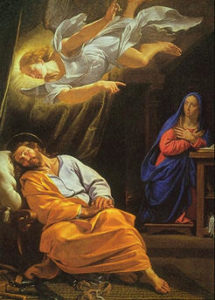The Dream of Saint Joseph, by Philippe de Champaigne.
Mount Calvary Church
A Roman Catholic Parish
The Personal Ordinariate of S. Peter
Eutaw Street and Madison Avenue
Baltimore, Maryland
December 22, 2019
Advent IV
Rev. Albert Scharbach, Pastor
Dr. Allen Buskirk, Choirmaster
Midori Ataka, Organist
8:00 A.M. Said Mass
10:00 A.M. Sung Mass
Brunch to follow in the undercroft
_______________
Organ Prelude
O Come, All Ye Faithful, Arranged by Hal H. Hopson
Organ Postlude
Offertoire sur Deux Noels, by Alexandre Guilmant
_________________
Common
Anglican Folk Mass, Shaw
_________________
Anthems
A Spotless Rose, Herbert Howells (1892-1983)
A spotless Rose is blowing sprung from a tender root, of ancient seers’ foreshowing, of Jesse promised fruit; its fairest bud unfolds to light amid the cold, cold winter and in the dark midnight. The Rose which I am singing, whereof Isaiah said, is from its sweet root springing in Mary, purest Maid; for through our God’s great love and might the blessed babe she bare us in a cold, cold winter’s night.
It is a simple setting of the anonymous fifteenth-century poem about Jesus’ birth and the purity of Mary, and the naivety of the words seem to give Howells the springboard to create something that appears the model of simplicity on the surface, but hides a deeper complexity – how many carols written in 1919 move mellifluously between 7 8, 5 4 and 5 8 with the subtle changes of metre emphasising the stresses of the words and Howells’s restrained homophony? The harmony moves seamlessly from a modal E major to the minor before returning to the major for the end of the first verse – then the magic happens! The second verse has a stunning tenor solo that brings a radiant glow to the music, but the skill is in the accompaniment given by the rest of the choir.
Perhaps the most celebrated moment of the piece is the very end, in fact the final cadence – this cadence (on the words “cold winter’s night) is one of Howells’s most sublime and affecting moments and the composer Patrick Hadley famously wrote to Howells saying “I should like, when my time comes, to pass away with that magical cadence.” The cadence itself moves from A minor to E major through some wonderfully piquant suspensions and unusual dissonance resolutions.
_________
Ave Maria, Gabriel Jackson (b. 1962)
Ave Maria, gratia plena, Dominus tecum; benedicta tu in mulieribus, et benedictus fructus ventris tui, Jesus. Sancta Maria, Mater Dei, ora pro nobis peccatoribus, nunc et in hora mortis nostrae. Amen.
Hail Mary, full of grace, the Lord is with thee; blessed art thou among women, and blessed is the fruit of thy womb, Jesus. Holy Mary, Mother of God, pray for us sinners, now and at the hour of our death. Amen.
This is a deeply compelling setting of the familiar text. The piece commences with a series of contemplative exchanges between the upper and lower voices; the ensuing, unexpected changes of key and texture are potently effective, and typical of Jackson’s compositional style.
Jackson comments:
Why compose yet another Ave Maria? After all, there are innumerable other settings of the Angelic Salutation, many of them great masterpieces. Yet any new treatment of even the most familiar words can, I hope, say something unique about them.
I have divided the bipartite text into three sections. In the first, divided sopranos and altos lead the hymning of the Virgin. After an impassioned and anguished outburst (“Sancta Maria, Mater Dei, ora pro nobis”), there follows a solemn and hushed prayer-chorale, while two solo sopranos soar heavenward in imploration.”
________________
Hymns
O Come, O Come Emmanuel is a translation of the Latin hymn Veni veni Emmanuel, which in turn is based on the seven O Antiphons, which are sung in the monastic office at the Magnificat on the days preceding Christmas. These antiphons are of ancient origin, dating back to at least the ninth century. The hymn itself, though, is much more recent. Its first appeared in the 18th century. It is interesting to note that the initial words of the actual antiphons in reverse order form an acrostic: O Emmanuel, O Rex, O Oriens, O Clavis, O Radix (“virgula” in the hymn), O Adonai, O Sapientia. ERO CRAS can be loosely translated as “I will be there tomorrow”.
__________
Creator of the stars of light is a translation by John Mason Neale (1818–1866) of the 9th century Creator alme siderum. The translation captures the essence of the original Latin. Contrasting “everlasting light” with the “stars of night” in the first stanza is a common theological theme of Latin hymns. Stanza two refers to the great New Testament hymn found in Philippians 2:10-11: “That at the name of Jesus every knee should bow, of things in heaven, and things in earth, and things under the earth; And that every tongue should confess that Jesus Christ is Lord, to the glory of God the Father.”
